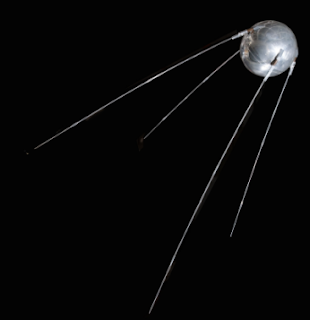Week 9: Space + Art
Our
final topic of this quarter of space is very current and will continue to be a
major focus of science and the arts for centuries to come. My favorite topics covered in the lectures
involved the first satellites and humans being sent into space.
In
1957, right smack dab in the middle of the Cold War, the Soviets launched
Sputnik I, the world’s first artificial satellite (NASA.gov). While the U.S. at the time had been focusing
on staying ahead of the arms race with the Soviets, the Russians chose to lap
the Americans in the space race. The
size of a beach ball, Sputnik I was designed to be elegant and received massive
media coverage of its launch, thanks to its ability to transmit radio signals
back to Earth (History.com).
Shortly
thereafter, in 1961, the Russians secured another victory in the space race
when they sent the first man into space, Yuri Gagarin (Redd). The United States, would respond, however,
with a massive push in space technology and innovation, sending the first man
to walk on the moon, Neil Armstrong, in 1969 (Dunbar).
 |
| Neil Armstrong |
The
human race has always been fascinated by space, and as such, many films and
documentaries have been created based on both fact and fiction with regards to
space. One of my favorite space films is
Apollo 13. The movie documents the tribulations
encountered by the men aboard the Apollo 13 spacecraft following the explosion
of oxygen tank no. 2 nearly 200,000 miles away from Earth, which caused oxygen
tank no. 1 to fail as well (Dunbar).
Thankfully, the three astronauts aboard the mission were safely brought
home.
The
film Apollo 13 does a great job of laying
out some of the horrors and unknowns when it comes to space travel, which has
been privatized in recent years. But with
the many horrors comes great fascination of the unknown, and this will continue
to drive space exploration for years to come.
References:
Dunbar, Brian.
“Apollo 13.” NASA, 29 Mar. 2017,
www.nasa.gov/mission_pages/apollo/missions/apollo13.html. Accessed 3 June 2017.
Dunbar, Brian.
“Biography of Neil Armstrong.” NASA, 10 Mar. 2015, www.nasa.gov/centers/glenn/about/bios/neilabio.html.
Accessed 3 June 2017.
Redd, Nola Taylor.
“Yuri Gagarin: First Man in Space.” Space.com, 24 July 2012,
www.space.com/16159-first-man-in-space.html. Accessed 3 June 2017.
“Sputnik and The Dawn of the Space Age.” NASA,
10 Oct. 2007, history.nasa.gov/sputnik/. Accessed 3 June 2017.
“Sputnik
Launched.” History.com, A&E Television Networks, 2009, www.history.com/this-day-in-history/sputnik-launched.
Accessed 3 June 2017.





Comments
Post a Comment